As a fantasy writer, one of the biggest things that attracted me to the genre was fantasy creatures. I love imagining new beings, mixing features and lore with ones that already exist, and incorporating those creatures into my stories to watch them interact with the world and characters.
If you’re interested in writing fantasy or sci-fi, you’re probably pretty familiar with a lot of different fantasy creatures that already exist. In your own writing, do you create your own unique beings, or do you use lore monsters and classic creatures?
This complete guide to fantasy creatures includes:
- What are fantasy creatures?
- What is the most famous fantasy creature?
- Benefits of having unique fantasy creatures in your novel
- How to create one-of-a-kind fantasy creatures
- What are some well known mythical creatures?
What are fantasy creatures?
A fantasy creature is an imagined being, usually for storytelling. Whether it’s novels, video games, art, or spoken folklore, fantasy creatures are present in any culture you can name. Ancient civilizations, every continent, every subcategory of place and person–they all have fantasy creatures.
The Middle-Eastern Manticore, the Cajun Rougarou, the Scottish Kelpie, the Zulu’s Tikoloshe. Everyone has fantasy creatures. They might be toted as fact (like creatures important for the religion or customs of different regions), or they might be stories people tell for fun (growing up in Louisiana, we were told the Rougaru would come eat children or turn them into Rougarus if they misbehaved).
Fantasy writers often pull from lore and fairytales to recreate them when writing their novels. However, fantasy writers might also take elements of one or more creatures to put their own spin on them. And other writers make up their own original creatures, which is hard to do!
A writer would be hard-pressed to come up with a completely original character that didn’t seem at least a little derivative of an existing creature, so don’t sweat originality too much.
What Is The Most Famous Fantasy Creature?
Contrary to being original, the most famous fantasy creature is the dragon. Dragons are known for being regal, powerful, and oftentimes, associated with wisdom. However, there are ways to make dragons a bit more original. Consider J.R.R. Tolkien’s dragon in The Hobbit.
This dragon acts more as a villain than a wise sage. He also bears many qualiteis that humanize him:
- He has a name, Smaug
- He is dedicated to his primary goal
- He enters into dialogue with the hobbits
- He has a weak point
Even though dragons are the most famous of fantasy creatures, you can create them with unique characteristics that make them original. Avoid the urge to create a dragon that fulfills every expectation and instead, layer in unexpected details.
Benefits of having unique fantasy creatures in your novel
If you’re writing a high fantasy, using epic fantasy creatures can make it a lot more exciting! They can also add conflict and richer worldbuilding.
Imagine if Tolkien wrote Lord of the Rings with no fantasy creatures. Just humans in a world with some magic–not as exciting or interesting, right? Adding unique animals and beings to your world is a crucial step in building a compelling and immersive fantasy.
A well-crafted fantasy creature can also make your story memorable and unique. It’s a real chance to use your creativity and logic to create “realistic” make believe.
So how do we create good fantasy creatures?
How to create one-of-a-kind fantasy creatures
You’re allowed to make up your own animals in your world, ones that can do and be whatever they please. However, if you create these fantasy creatures with intention to add to and build your story, it’ll be far more effective and memorable.
Here’s how to make fantasy creatures people create fan art for:
1. Consider the fantasy world they live in
The environment, lore, history–even politics and religion–can affect the creatures that are created and exist in your world. Think about what creatures would reasonably exist in the environment you’ve created. Would any of them be exterminated, relocated, or hunted? Are they sacred or worshipped?
As an example of using the environment to shape the creatures, here’s a short list of creatures I used in my fantasy novel who live in the swamp environment.
- Komars. Komars are hivemind swarms of giant mosquito-like creatures with scimitar claws. Mosquitos love warm, humid places, so having a similar fantasy creature in the swamp made sense for that location.
- Adelaide. Adelaide is a character who lives and works in the swamp, and she’s a scaly, amphibious person. Her biology and instinctual behavior makes her adept at surviving in an unforgiving swampscape.
- Ragondin. Ragondin is a giant mount animal who resembles a nutria rat. He’s not sentient in the way humans are, but he works with Adelaide and acts as a named character. His coarse hair, thick tail, fat mass, and high nostrils make him perfect for swimming in murky water for long periods of time.
- Garou. Garou is one of many swamp villains. He’s a wolf-human hybrid. Garou is influenced by the Cajun Rougarou and acts similarly to the lore I heard growing up.
All of these creatures work together to create the world of my swamp setting, and all contribute to the vibes, themes, plots, and character arcs that happen there. If you put any of the creatures I listed in another environment in the same universe (which I do a few times in the books), they would stick out and struggle.
That’s how well you want your creatures to make sense for the environment, because it makes for a much more believable world that your readers can really immerse themselves in.
We have a great blog post all about building a realistic fantasy world right here so you can get started.
2. Consider how the creatures interact with the characters and plot
Understand your creature’s place in the story universe. Is your creature its own sentient species?
Are they a friend, a pet, an enemy? What does the element of a fantasy creature add to your story, to the scene it’s in, and to your character arcs?
How can your creature create conflict for a scene or plot point in your novel?
Think about the ways in which your fantasy animal can play a role, and not just be a distant addition to your worldbuilding. When characters come into contact with them, it can make the world feel so much bigger and more real than if they’re just observed.
3. Build their physical features
This is where it gets fun. You can develop the way your character looks based on factors like its environment, its origin, and its purpose. You can pull ideas and elements from real animals or creatures of lore and fairytales.
If you’re taking a classic creature, like a vampire or an elf, what original thing can you bring to them? For example, Stephenie Meyer took vampires, introduced the concept of vegetarianism, and made them sparkle in sunlight.
You may love fairies, but but wonder what creatures are similar to fairies and could better fit your story. For instance, pixies are similar to fairies but are mischievous and associated with British folklore. Depending on your story world, plot, and characters, pixies may contribute to your story better than fairies.
There are benefits to taking a creature that already exists, like a vampire, because the groundwork is already done. Your reader knows what a vampire is. But then they get to learn what makes your (or Meyer’s) vampires unique in that universe.
Here are a few things to consider when you’re crafting your fantasy creature’s physiology:
- Evolution. What did previous iterations of this creature look like? Why did it develop in this way? Does it have vestigial features?
- Features. Wings, limbs, horns, tails, scales, fur–there are endless combinations of endless lists of feature elements. It can be hard to decide! Consider what use each of these features would have for the creature and its thriving (or failure) in an environment.
- Colors and patterns. This could just be for fun, or maybe your creature survives through camouflage or other pattern-related techniques. Also consider what the colors and patterns can mean for the creature socially–are some considered more attractive? Are some colored specifically to attract mates?
- Size. How big is your creature? How much does it weigh? Can it change its shape or size? How does its size change from infancy to adulthood?
- Variations and subspecies. How are members of the same species different from each other, and are there categorically different types?
- Habits, diet, etc. Knowing how your creature spends its time can help you decide what it looks like, how it acts, and what it needs to survive and thrive.
What are some well known mythical creatures?
Let’s look at a few examples of fantasy creatures to get some ideas flowing! You can definitely use these in your own novels, but we challenge you to think a little broader and instead pull inspiration from the below examples and tweak them to make them unique with the tips above.
1. Phoenix
The phoenix is a mythical bird associated with Greek roots that is known for its cyclical regeneration. It ignites at the end of its life cycle, regenerating and emerging as a new creature–sometimes as a newborn version of itself, and sometimes as a new creature entirely. Phoenixes are where we get the cliche “rising from the ashes.”
2. Centaur
A centaur is a creature with the head, torso, and arms of a human, but the legs and body of a horse. They also come from Greek mythology, with various possible origins, all of which involve a human breeding with a horse, to confirm your fears.
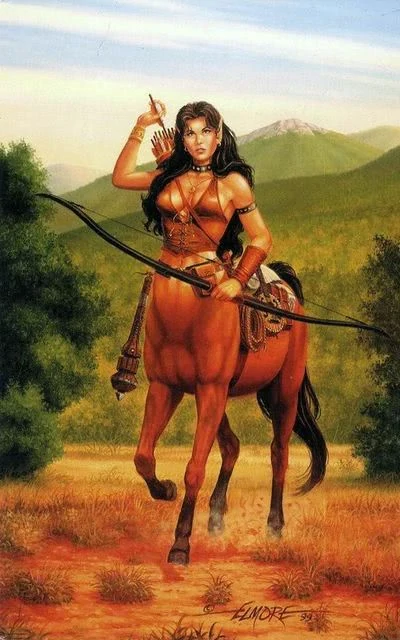
3. Dragon
Everyone knows what a dragon is, because there’s a version of them in every culture. This might be due to individual nations discovering the remains of dinosaurs and drawing conclusions.
An anthropologist (David E Jones) suggested that the fear of snakes is so common in humans due to an evolutionary fear recognition of dragons. That might seem like a silly assertion, but consider that it’s also very fun.
4. Selkie
Selkies are creatures that can shift from human form to the form of a seal. They come from Norse and Celtic mythology, featured in many stories and folktales.
The most popular stories involve a man finding the selkie’s skin (sometimes taking the form of a fur coat or another type of outerwear), hiding it, and forcing her to stay human and marry him (gross). Song of the Sea is an animated film featuring a selkie character.
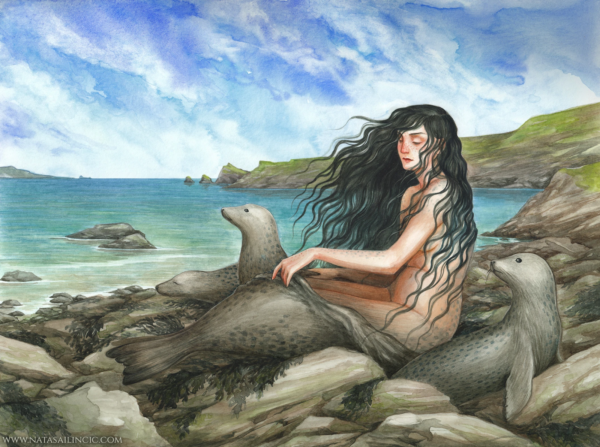
5. Griffin
Griffins are another mishmash creature, with the body of a lion and the wings and head of an eagle. Some griffins may also have eagle talons. The griffin is a powerful creature in mythology, because the lion and eagle are both seen as kings of the animal kingdom.
They appear in most tales as guards of treasure or other highly valued things. Some myths include that the griffin lays its eggs underground, and if you dig them up, you’ll find they’re surrounded by nuggets of gold. If I didn’t want people disturbing my eggs, I personally wouldn’t bury them with gold nuggets, but who am I to judge the choices of a griffin.
6. Bandersnatch
I’m including this gangly doofus because he has a specific and clear origin–Lewis Carroll. Carroll became famous for works like Alice in Wonderland and Through The Looking Glass. The first mention of the bandersnatch is in Carroll’s poem, Jabberwocky:
“Beware the Jabberwock, my son!
The jaws that bite, the claws that catch!
Beware the Jubjub bird, and shun
The frumious Bandersnatch!”
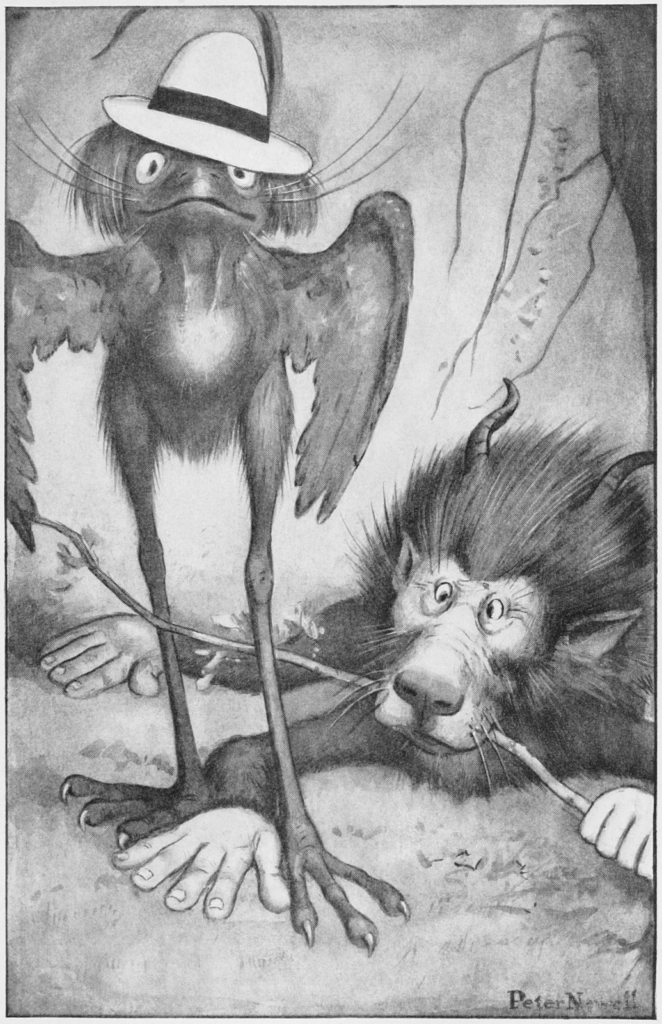
7. Mermaid
Everyone knows what a mermaid is because, just like the dragon, there are iterations of the mermaid myth in nearly every culture. With the tail of a fish and the torso of a human, the mermaid has found herself in countless iterations and stories. One early sighting rumor was made by the infamous bandersnatch, Christopher Columbus, who mistook manatees for mermaids.
8. Werewolf
Speaking of creatures that multiple cultures independently invented, the werewolf is a creature who shifts back and forth between a human and a wolf. The rules and circumstances of that transition depend on the story. Some werewolves can control their shift, some turn on full moons or other key times without control, some only start shifting after they’ve murdered someone to enact a curse (shoutout Vampire Diaries).
9. Dryad
The dryad is a tree spirit or nymph. Sometimes they present as ghostlike figures of women, as lively trees, or as a person made of petals or leaves that can blow through the wind and reform whenever they please (shoutout Narnia). They’re usually quiet and shy, with people only catching glimpses of them in the deep forest.
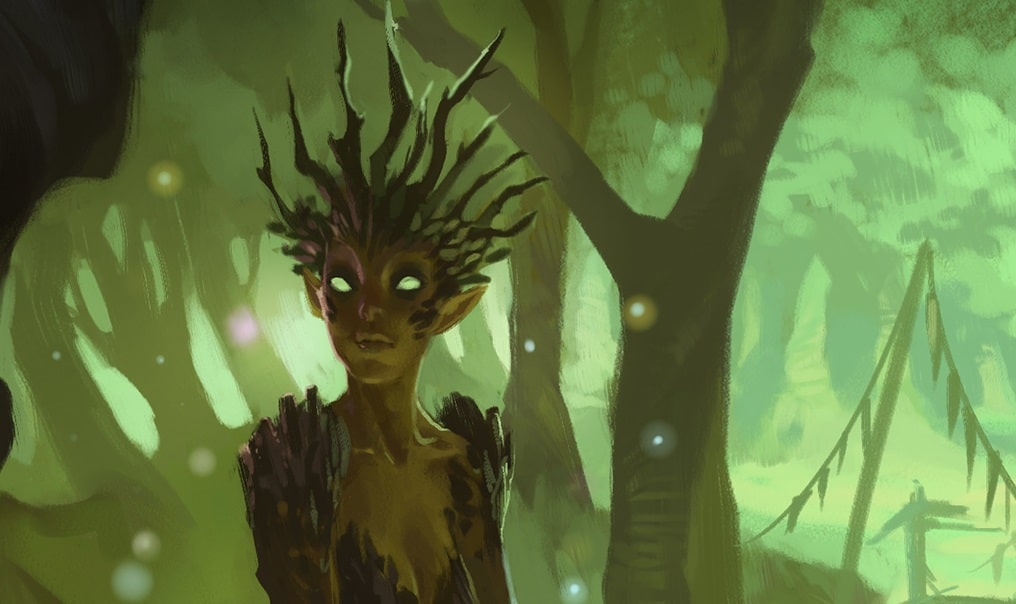
10. Golem
The golem finds roots in Jewish lore. They are human-like creatures, typically presented as clunky, clumsy beings that lumber around like Frankenstein’s monster. The golem is made of clay, mud, or other earthy substances. Their underdeveloped nature is probably due to Biblical influence, where “golem” is used to reference the unfinished person in God’s eyes.
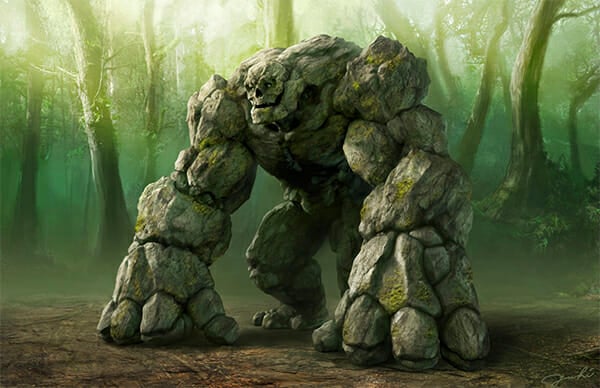
11. Chupacabra
The Spanish translation of “chupacabra” is “goat-sucker.” If you think that means this silly little guy sucks on goats, you’ve nailed it.
Chupacabra’s main hustle is its vampiric treatment of treasured farm friends. Some tales represent it as a furry, doggish creature, while others describe it as reptilian. While there have been sighting reports of the goat sucker all over the world, the majority originate in South and Central America.
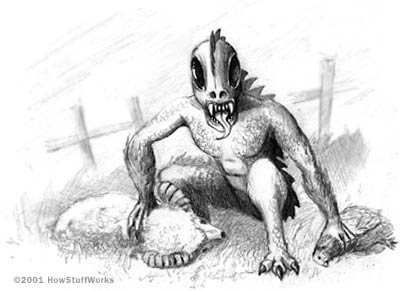
12. Fur-bearing trout
This is a goofy little guy you might hear about in Icelandic and American lore. It’s exactly what it sounds like–a little fishy with a fur coat. Why?
To keep warm, to be fashionable. Like most fantasy creatures, the fur-bearing trout has multiple origin stories–from the water being so cold that they rapidly evolved, to hair tonic being spilled in the river. Either way, I think he’s charming.
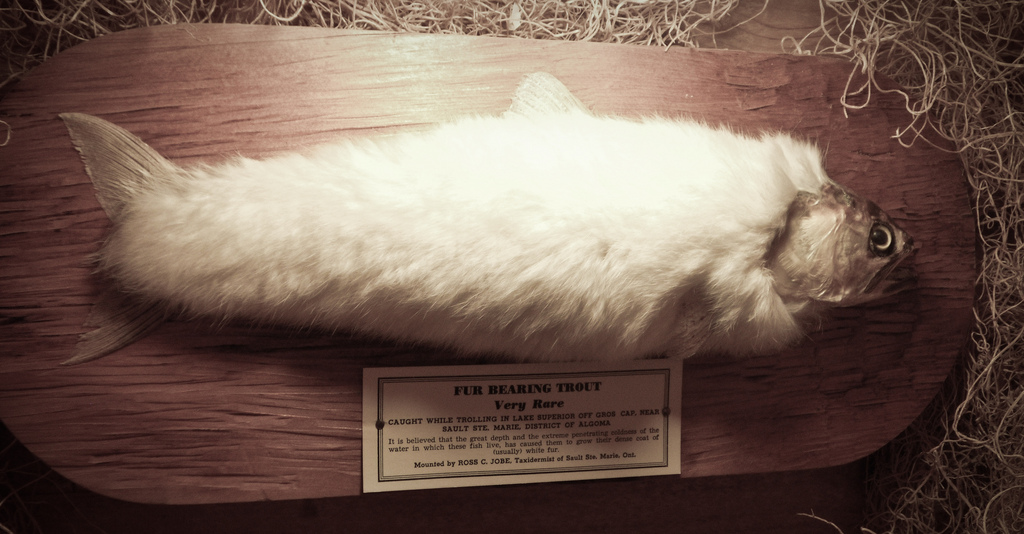
Do you have a favorite fantasy creature? Are you having ideas for how to create your own? Let us know in a comment!
